I’ve been runner for a little over 3 years now. It’s a blink of an eye really; less time than a senior on the local high school’s cross country team. Well, I guess that previous statement is not entirely true. I’ve been a runner since the day I was born, but it’s only in the last 3 years that I have been a competitive runner.
One of the biggest realizations I have had over the last few years is that the more I learn about running, the more I want to learn. I'll be the first to admit that I’m by no means an expert, but I am a little obsessive and enjoy geeking out with a running website, magazine, podcast, you name it. I have learned an amazing amount from more experienced runners than myself and what I’d like to do now is share a bit of that with you. I hope, but can’t promise, you’ll learn something.
As you read through this list of a few concepts, tools and equipment that have helped me improve my running, remember that we are all experiments of one; what worked well for me might not work for you. Question everything, do your own research, and listen to your body.
In this post I will share a few techniques I have learned. And in a follow-up post I will share a few of the products and supplements I have found to help my running.
Minimalist Running
By far, the concept that has most improved my running was changing to a minimalist or natural style of running. I believe that minimalist running is why I am running strong today.
I know that many visitors to this site already know quite a bit about minimalist running technique, but I think it's worth sharing what minimalist running means to me. To me, minimalist or natural running is exactly what it sounds like - to run with as little separating your feet, body, and mind from your most naturally fluid motion.
Minimalist running means letting our amazing bodies do what they've developed to do over millions of years. Instead of relying on the latest running shoe technology, minimalist runners rely on the strength of our bodies.
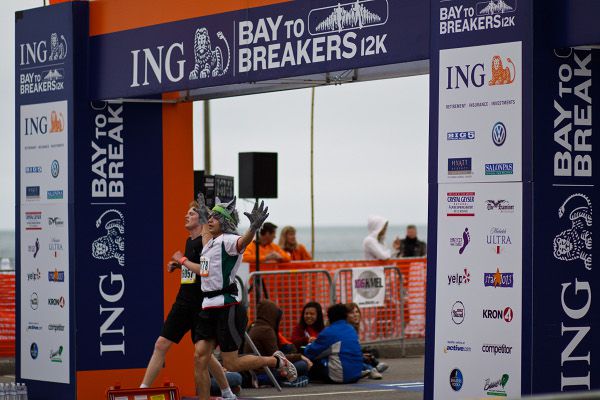
Minimalist running involves a form and technique that includes: good posture; a short, quick stride; a soft midfoot landing; and a slight forward lean from the ankles, not the hips. I know the previous description was brief, but rather than go into detail about running form or technique I prefer to share with you a few of the many great resources that are available online.
Here are some of my favorites:
- VIVOBAREFOOT Training and ebook.
- The Principles of Natural Running
- Good Form Running
- The 3R's: Real Running Reminders
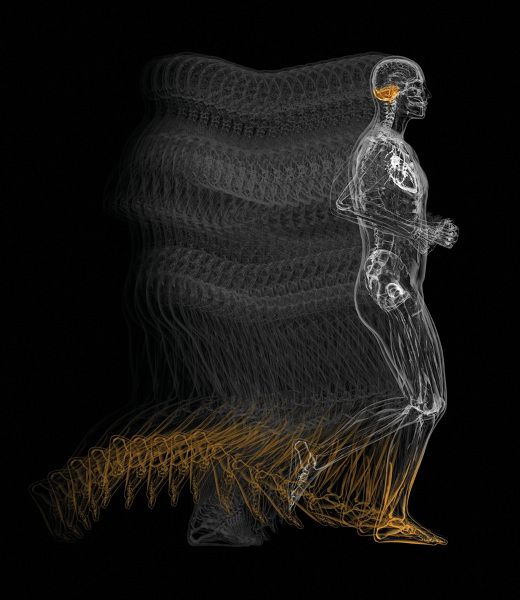
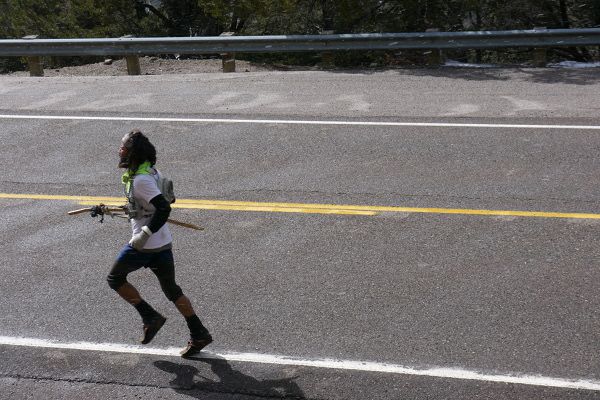
Proper Footwear
Like most anything, running should be built upon a strong foundation. In the case of running, a strong foundation is literally strong feet. I believe that years of wearing shoes designed for looks over function have left our feet weak, and deformed. We have slowly become dependent on our shoes for comfort and support instead of relying on our body's natural strength.
I believe that for our feet to regain their strength we must allow them to function without hindrance. This is why I think the best running shoes are light, wide, flexible, flat and low. That list of adjectives may appear simple and specific, but it’s amazing how varied the footwear that meets those requirements can be.
Minimalist shoes can now be found for any terrain or situation, from the gnarliest rock covered trail, to the miles of endless asphalt. I am not going to get into specific shoe models in this post, but take a look around the site and I'm sure you will find a pair of shoes that interests you. When you find a pair of shoes you think you’d like, ask questions, because all of the site's contributors would be happy to help you find a pair that works.
Just remember, if your feet have spent 10, 20, 30+ years in a typical running shoe with a huge, thick heel and built-up structure you can't jump into a pair of minimalist shoes and run 15 miles the next day. The progression away from your old shoes has to be gradual, but the running freedom that will reward the transition is more than worth the effort.
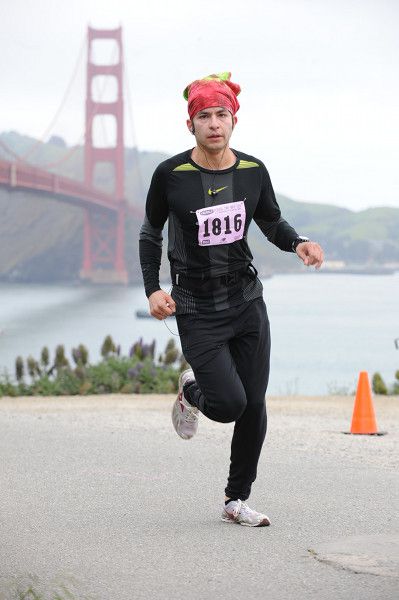
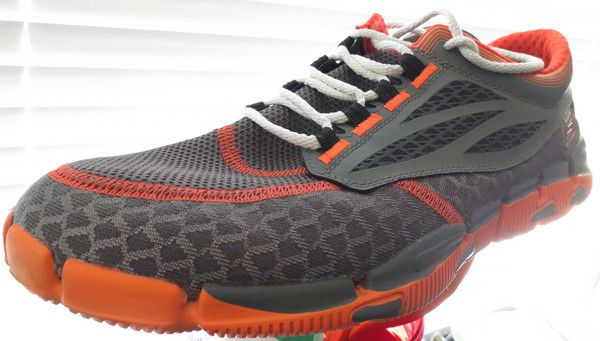
MAF or Aerobic Focus to Exercise
I have to preface this section by again stating that I am not an expert in human physiology. What follows is my understanding of a complex concept. If you are intrigued by MAF training, I encourage you to search out additional resources. I have provided a link further in this post as a good place to start.
Maximum Aerobic Function (MAF) is a training technique/principle that has attracted significant attention from the endurance sports community over the last few years. MAF training can mean different things to different people. When I speak of MAF I am referring to a training principle that uses heart rate, instead of pace, as a guide for effort. MAF training is intended to develop our aerobic systems.
As background, exercise can grossly be broken down into aerobic, meaning with oxygen, and anaerobic, meaning without oxygen. The anaerobic system is heavily recruited during quick, explosive movements like lifting weights or sprinting and since the anaerobic system is fueled using sugar (glucose from glycogen) already present in our blood, muscles, and liver the anaerobic system doesn't require oxygen to generate energy.
On the other hand, the aerobic system, which is more heavily recruited during endurance activities such as long distance running, biking, etc., uses primarily fat as an energy source. Oxygen is required to convert the fat into a useable fuel source, hence the term aerobic, "with oxygen".
This key difference between fuel sources for an aerobic versus an anaerobic effort is why our bodies are able to sustain prolonged aerobic efforts without external fuel sources, but a prolonged anaerobic effort will likely result in the dreaded bonk. Since our bodies can store significantly more fat than sugar (glycogen), exercise that uses fat as a fuel can be sustained for much longer than exercise that uses glycogen as a fuel. Lastly, the stress placed onto the body by anaerobic exercise is significantly higher than the stress experienced at an aerobic effort.
So what does all this mean for runners? When I first began learning about MAF and fat adaptation (improving the body’s ability to fuel with fat) I interpreted it to mean that if I reduced the intensity of my exercise I would improve my body's ability to provide its own fuel for long runs. I would reduce the stress experienced from increasing mileage and reduce my chance for injury.
For such a complex and technical concept, its application is relatively simple; figure out the heart rate at which your body switches over from using mostly fat as a fuel source to mostly sugar and spend as much time as possible training just below that heart rate. While there are very accurate lab tests that can be done to determine your appropriate training heart rate, myself and many others have had good success applying the "180 - Age" formula developed by Phil Maffetone
In my case the formula works out to a MAF HR of 149. Therefore, over the last 8 months or so, I have tried to train at a heart rate of 145-155 on most of my runs. I occasionally do run outside of that range during some trail sessions or races.
As a word of warning it is quite likely your aerobic system is not well trained and keeping your heart rate in a MAF zone will require you to slow down quite a bit from your usual effort. This slowdown was the hardest part of applying this concept. It is challenging to resist the urge to run fast, but trust in the system. If you can accept that training slower will benefit you more than constantly pushing the pace, I am confident you will see improvement.
As an example, over the time that I have trained at my MAF HR I have seen my pace at the same heart rate drop from about 8:50 min/mile to about 7:30 min/mile and I set both a marathon and half marathon personal bests with almost no "speedwork".
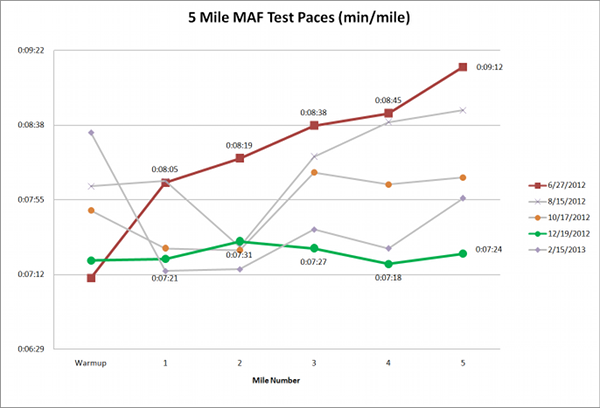
I now feel that I have developed the base that I skipped during my early days of training and expect that I will be able to build upon that base with the controlled addition of speedwork and tempo runs to set another marathon personal best this year.
As an additional benefit, I have also noticed a reduced incidence of illness over the last year. Remember that exercise is stress and too much stress from any source: work, diet, lack of sleep, or overtraining can all lead to a weakened immune system and may leave you open for illness to invade. I believe that reducing my training intensity allowed me to increase my training volume without weakening my body's ability to defend itself from the colds and flus that seem to have wrecked all of the other people in my office and family.
R&R
To many people the saying R&R means "Rest and Relaxation" to me R&R has come to mean "Rest and Rolling". As I began to look at running and training in terms of the stress they place on my body I recognized the importance of rest. Knowing when to rest means allowing my body a day off as soon as there are signs it needs it instead of waiting until an injury forces a break.
It is critical to accept that rest can be as important as the hard efforts of training. Rest comes in many forms: rest can mean taking a day off when my body feels tired, or rest can mean taking a real "easy day" where I run at much slower pace than typical to allow my body to break up soreness and increase circulation to my legs.
In my early days of running, I fell into the common bad habit of hitting every run hard. I was convinced that the best way to make gains was to give every run as much as I had. I used to head out trying to cover more ground in the same time every day, and while this did yield a great time during my first race, it also set me up for injury and illness.
I was lucky to avoid the major injuries (stress fractures, serious strains) but I now know that I was pushing it too hard and the efforts were not sustainable long term. I've slowly accepted that every training run isn't a race and that there is no shame in running slowly. When I am out on a recovery day run I no longer feel compelled to speed up every time someone passes me on the road or trail.
Accepting this new attitude has been complimented by remembering that real rest (days off!) are as important as the actual running. I now make sure to take a day off anytime I even think I need it, because it’s much more likely that I will fool myself into running when overtrained than fooling myself into becoming overly rested.
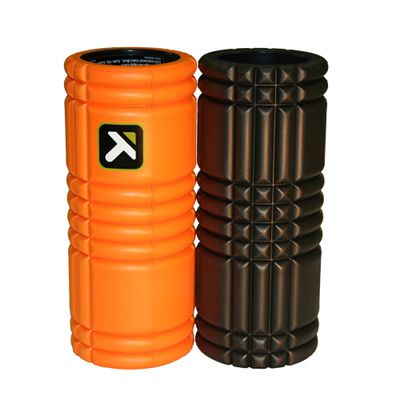
The second key "R" is rolling. Over the last few years I have come to rely on the benefits provided by foam rolling to aid recovery. If I was an elite, professional runner I would have an army of therapists working out every kink and sore muscle but I am not, so I have to put in the effort to work on my own sore muscles.
On the advice of my uncle and other runners I decided to try foam rolling and purchased a slightly expensive but very effective roller and I believe it has more than paid for itself in recovery gains. What I like about using a foam roller is that its effectiveness can be felt almost instantly. I use my roller on my calves, quads, hamstrings, hips, IT bands and back almost every day that I run; and I notice that if I start out sore and tight I will usually feel much less sore by the end of a short session of rolling.
I usually use my roller in the evening while watching a little television or listening to music so I've decided there is really no excuse for skipping it. When I do get lazy and skip multiple days of rolling in a row I notice that my legs feel tighter, sorer, and generally more beat up during runs. For that reason, I have made it my personal goal not to skip more than one session in a row. This dedication to rolling has paid off with over a year of injury-free running.
As an added benefit, on the days after a good rolling session, my abs will feel a bit sore since they are heavily engaged during the rolling session so I believe I am getting a bit of a core work out from the rolling as well. I will also add that you shouldn’t neglect your feet when rolling. I use a small ball to roll out the bottoms of my feet and find it significantly reduces the “top of foot pain” common for minimalist runners.
(Editors note: For more info on specific techniques for self massage, check out our article How to Treat and Prevent Injury.)
This is the end of part one of What Three Years as a Runner Has Taught Me. My next post will cover supplements I use, goals and vision, the importance of trail running, and sticking to it.
